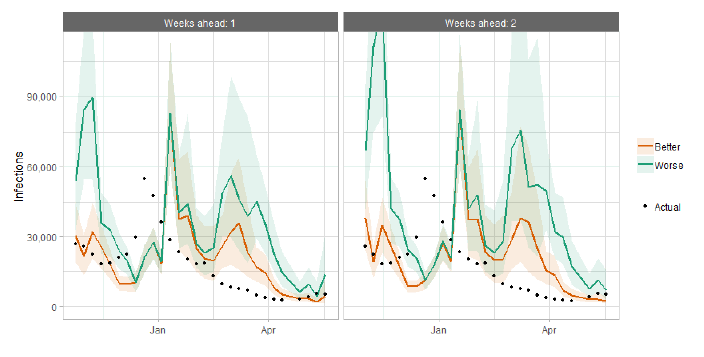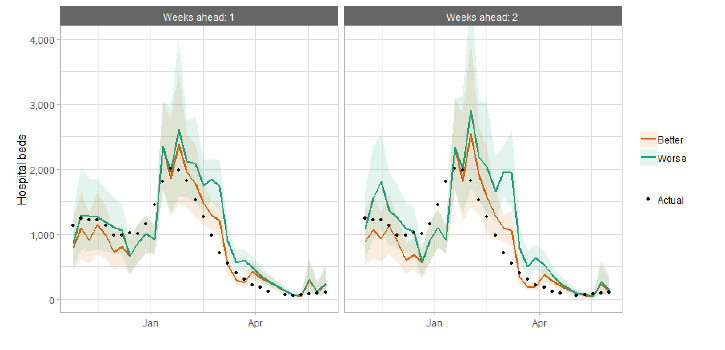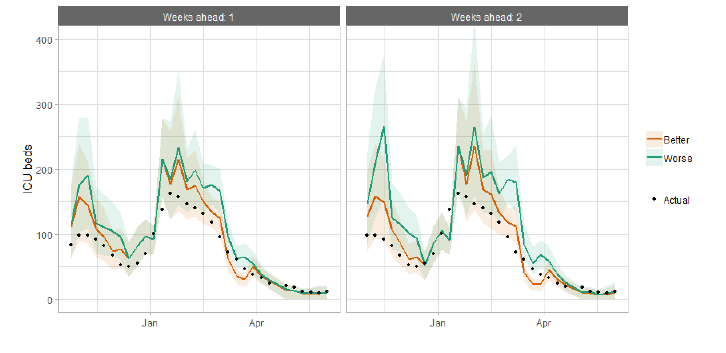Coronavirus (COVID-19): modelling the epidemic (issue no. 54)
Latest findings in modelling the COVID-19 epidemic in Scotland, both in terms of the spread of the disease through the population (epidemiological modelling) and of the demands it will place on the system, for example in terms of health care requirement.
This document is part of a collection
Technical Annex
Better and Worse Scenarios
Due to the large areas of uncertainty around the path of the epidemic, both in how many people could be affected and in how quickly it could happen, we provide two projections for estimated infections and hospital demand, illustrating what might happen in two broad scenarios.
In this issue, the difference between the Better and Worse scenarios illustrates the difference between a significant (Worse) and not significant (Better) impact from the delta variant. For the Worse scenario, we assume the delta variant is between 20% and 60% more transmissible than the alpha variant, while in the Better scenario we assume they are the same.
Both scenarios cover the same wide range of behavioural patterns, from decreased mixing in comparison to now to increased mixing.
How the modelling compares to the real data as it emerges
The following charts show the history of our modelling projections in comparison to estimates of the actual data. The infections projections were largely accurate during October to mid-December and from mid‑January onward. During mid-December to mid-January, the projections underestimated the number of infections, due to the unforeseen effects of the new variant.
Figure 21. Infections projections versus actuals, for historical projections published between one and three weeks before the actual data came in.

Hospital bed projections have generally been more precise than infections estimates due to being partially based on already known information about numbers of current infections, and number of people already in hospital. The projections are for number of people in hospital due to Covid-19, which is slightly different to the actuals, which are number of people in hospital within 28 days of a positive Covid-19 test.
Figure 22. Hospital bed projections versus actuals, for historical projections published between one and three weeks before the actual data came in.

As with hospital beds, ICU bed projections have generally been more precise than infections. The projections are for number of people in ICU due to Covid-19. The actuals are number of people in ICU within 28 days of a positive Covid-19 test up to 20 January, after which they include people in ICU over the 28 day limit.
Figure 23. ICU bed projections versus actuals, for historical projections published between one and three weeks before the actual data came in.

| LA | P (Cases > 500) | P (Cases > 300) | P (Cases > 100) | P (Cases > 50) |
|---|---|---|---|---|
| Aberdeen City | 0-5% | 0-5% | 5-15% | 15-25% |
| Aberdeenshire | 0-5% | 0-5% | 5-15% | 15-25% |
| Angus | 0-5% | 0-5% | 5-15% | 50-75% |
| Argyll and Bute | 0-5% | 0-5% | 5-15% | 15-25% |
| City of Edinburgh | 25-50% | 25-50% | 75-100% | 75-100% |
| Clackmannanshire | 0-5% | 5-15% | 50-75% | 50-75% |
| Dumfries & Galloway | 0-5% | 0-5% | 0-5% | 5-15% |
| Dundee City | 15-25% | 25-50% | 75-100% | 75-100% |
| East Ayrshire | 0-5% | 0-5% | 50-75% | 75-100% |
| East Dunbartonshire | 0-5% | 0-5% | 50-75% | 75-100% |
| East Lothian | 0-5% | 0-5% | 15-25% | 50-75% |
| East Renfrewshire | 15-25% | 50-75% | 75-100% | 75-100% |
| Falkirk | 0-5% | 0-5% | 25-50% | 50-75% |
| Fife | 0-5% | 5-15% | 25-50% | 75-100% |
| Glasgow City | 15-25% | 25-50% | 75-100% | 75-100% |
| Highland | 0-5% | 5-15% | 25-50% | 50-75% |
| Inverclyde | 0-5% | 0-5% | 5-15% | 50-75% |
| Midlothian | 5-15% | 15-25% | 75-100% | 75-100% |
| Moray | 0-5% | 0-5% | 0-5% | 5-15% |
| Na h-Eileanan Siar | 0-5% | 0-5% | 0-5% | 0-5% |
| North Ayrshire | 0-5% | 5-15% | 50-75% | 75-100% |
| North Lanarkshire | 15-25% | 25-50% | 75-100% | 75-100% |
| Orkney Islands | 0-5% | 0-5% | 0-5% | 0-5% |
| Perth and Kinross | 0-5% | 0-5% | 15-25% | 50-75% |
| Renfrewshire | 25-50% | 50-75% | 75-100% | 75-100% |
| Scottish Borders | 0-5% | 0-5% | 0-5% | 5-15% |
| Shetland Islands | 0-5% | 0-5% | 0-5% | 0-5% |
| South Ayrshire | 5-15% | 15-25% | 50-75% | 75-100% |
| South Lanarkshire | 5-15% | 25-50% | 75-100% | 75-100% |
| Stirling | 0-5% | 5-15% | 50-75% | 75-100% |
| West Dunbartonshire | 0-5% | 0-5% | 5-15% | 25-50% |
| West Lothian | 0-5% | 0-5% | 25-50% | 50-75% |
What levels of Covid-19 are indicated by wastewater (WW) data?
Table 2 provides population weighted daily averages for normalised WW Covid-19 levels in the weeks covering 16th – 22nd May and 23rd – 29th May, with no estimate for error. This is given in Million gene copies per person, which approximately corresponds to new cases per 100,000 per day. Coverage is given as percentage of LA inhabitants covered by a wastewater Covid-19 sampling site delivering data during this period.
| Local Authority | 16th – 22nd May | 23rd - 29th May | ||
|---|---|---|---|---|
| Average daily WW Case Estimate per 100k | Average daily WW Case Estimate per 100k | Average daily WW Case Estimate per 100k | Local Authority WW Coverage | |
| Aberdeen City | 0.6 | 80% | 2.5 | 80% |
| Aberdeenshire | 0.6 | 51% | 1.2 | 40% |
| Angus | 4.3 | 56% | 6.0 | 56% |
| Argyll and Bute | 0.5 | 18% | 4.8 | 18% |
| City of Edinburgh | 4.3 | 96% | 13.0 | 96% |
| Clackmannanshire | 4.8 | 81% | 12.9 | 81% |
| Dumfries & Galloway | 0.6 | 32% | 0.0 | 30% |
| Dundee City | 5.1 | 100% | 7.7 | 100% |
| East Ayrshire | 7.0 | 72% | 13.0 | 60% |
| East Dunbartonshire | 7.4 | 99% | 17.6 | 99% |
| East Lothian | 3.7 | 65% | 13.0 | 56% |
| East Renfrewshire | 36.0 | 95% | 39.5 | 95% |
| Falkirk | 9.3 | 69% | 4.0 | 59% |
| Fife | 4.4 | 85% | 3.2 | 85% |
| Glasgow City | 22.1 | 75% | 29.0 | 75% |
| Highland | 0.3 | 37% | 0.1 | 32% |
| Inverclyde | 4.6 | 92% | 3.7 | 92% |
| Midlothian | 18.5 | 88% | 20.7 | 88% |
| Moray | 2.0 | 55% | 5.0 | 55% |
| Na h-Eileanan Siar | 0.0 | 21% | 0.0 | 21% |
| North Ayrshire | 9.9 | 93% | 8.2 | 93% |
| North Lanarkshire | 6.1 | 83% | 11.3 | 91% |
| Orkney Islands | 0.0 | 34% | 0.0 | 34% |
| Perth and Kinross | 0.8 | 45% | 2.8 | 38% |
| Renfrewshire | 9.2 | 57% | 23.4 | 57% |
| Scottish Borders | 0.6 | 56% | 0.1 | 30% |
| Shetland Islands | 0.0 | 29% | 0.0 | 0% |
| South Ayrshire | 5.7 | 88% | 11.7 | 88% |
| South Lanarkshire | 11.7 | 74% | 13.9 | 88% |
| Stirling | 0.8 | 10% | 68.2 | 10% |
| West Dunbartonshire | 3.7 | 98% | 10.3 | 98% |
| West Lothian | 3.7 | 79% | 8.3 | 78% |
Contact
There is a problem
Thanks for your feedback